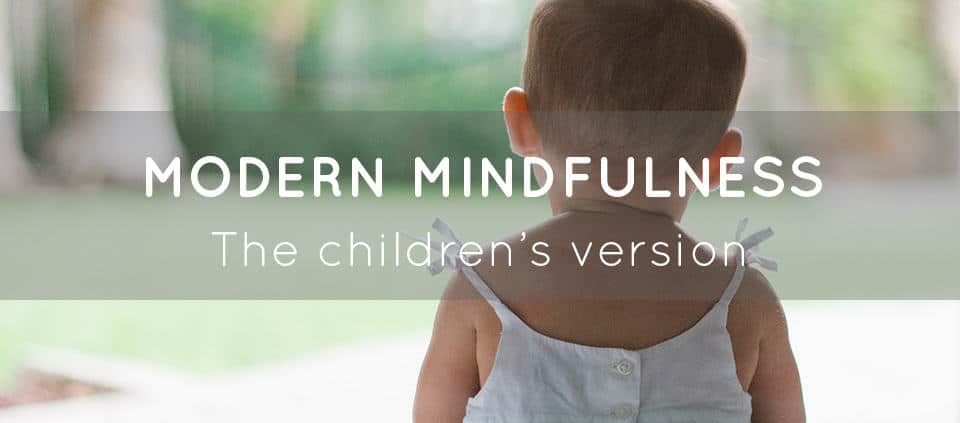Modern Mindfulness: The Children’s Version
Have you ever looked at your child in a moment where they are completely losing it and have it dawn on you that they currently have no control over their behavior? Given that most adults have moments when they’re not choosing their own thoughts or actions, it’s not surprising that kids have difficulty with this, too.
Practicing mindfulness is challenging for most, especially in a world where we are constantly over inundated with noise, deadlines and cell phone pings. While adults are harder to teach due to these distractions and years of established habits, children are apt to learn new things quickly, especially when they can immediately recognize the benefits. This is the case with mindfulness.
Before you write this off as hippy-like talk, mindfulness is the ability to notice what’s happening around you and recognizing your senses, thoughts, and feelings. And why is this important? By taking the time to process things, your children are better equipped to deal with their emotions which inevitably makes it easier for them to focus. These concepts may seem abstract, but hopefully the suggestions below will help you understand the benefits of teaching your children mindfulness.
Dinner Dates
Imagine you were on a first date with someone you were really interested in. You would ask them all sorts of questions, taking genuine interest in hearing their answers. Take this approach with your children, focusing on asking them questions to help highlight the way things affected them throughout the day. Let them talk about their feelings!
A good daily question is, “What made you laugh today?” This oh-so-simple question will not only allow you to enjoy their retelling of events, but it also brings forth a positive memory. Recalling negative memories is something that mostly happens unintentionally as yucky things creep back into our mind inadvertently, but if we can teach our children to choose to think about happy things, it will lessen the effect of the negative things as positivity now takes up more of their brain space.
Wandering Walks
We live in a busy world, and you probably say, “Hurry up” about as much as you say, “Calm down.” With working, breastfeeding schedules, PTA meetings, and everything else that comes with parenting, families are often in a rush. On occasion, try taking a walk without a destination in mind. Don’t have a plan, rather explore together.
Perhaps you point out the way the light beams through beautifully between two trees, venturing toward it to feel the temperature difference between the light and the shade. Or maybe your child spots a bird they find intriguing and you ask them to quickly close their eyes and tell you what color the bird’s tail was. Maybe instead you ask them to listen to the sound of its fluttering wings. Learning to pay attention to the things that don’t normally capture our attention (like homework and schedules) increases appreciation for the little things and how they can affect you.
Establish a gratitude practice
Giving thanks isn’t just limited to Thanksgiving. Asking your children to express what they’re thankful for has many benefits. First, it means they’ll appreciate those things more, and it will also help you, as a parent, understand what they value and what’s important to them. It’s also a helpful tool in combatting complaints.
For example, if your child is moaning about only having chocolate chip cookies when they really wanted sugar cookies, you can gently say, “Perhaps we should think about how lucky we are to have cookies, and how many children don’t get to experience this yumminess.” This won’t work miracles overnight, but over time the slight repositioning becomes part of their own thought process, and the grumblings about silly things begins to decrease.
Breath Work
As parents, we often look to see if children have listened by their actions, however we sometimes fail to remember that it’s their thoughts that control their actions. Instead of asking them to stop what they’re doing, instead give them something else to focus on, like their breath. This may sound a bit mumbo-jumbo, but trust us, it works.
First, ask them to close their eyes, breathe slowly and picture their breath moving through their body. Talk them through it, asking them to imagine it moving down their throat, into their chest, and all the way down into their belly. Then, ask them to visualize it as it moves back up and out. This practice will shift their attention inward, slow their breath, calm their nervous system, and allow them to relax. It can be especially useful when your 4 year old is mumbling incoherently while sobbing because she wants to wear shorts, but can’t because it’s 45 degrees outside. It won’t help her to understand the adult logic behind your forbiddance of summer wear, but it will calm her and give her space to accept her emotions, and then let them go and move on with her day.
While the suggestions above aren’t inclusive of all that encompasses achieving mindfulness, they are easy-to-implement ideas that can help your children learn to process their thoughts, feelings, and the world around them.





I focus on my breath. Breathing normally and consciously inhale and exhale. I mentally say “inhale” on the inhale and “exhale” on the exhale. Only type of meditation I do during a Migraine. I know the importance of mindfulness and do it often. But I don’t mind dissociating a bit when I’m in the middle of an attack.